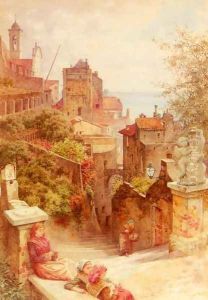Charles Gregory, RWS Paintings
Charles Gregory was an English artist known for his watercolor paintings. Born in 1810, Gregory became a member of the Royal Watercolour Society (RWS), an institution that was founded in 1804 and is known for promoting the art of watercolor painting in Britain. Although not as widely recognized as some of his contemporaries, Gregory's work contributed to the Victorian era's appreciation of watercolors as a legitimate and respected medium for serious artistic expression.
During his lifetime, Gregory would have been part of a movement that saw watercolor painting evolve from primarily a sketching tool to a medium that was capable of conveying intricate details and rich color schemes. Victorian artists were known for their attention to detail and often depicted historical scenes, landscapes, and the natural world with a precision that became a hallmark of the era.
Gregory's work would have been exhibited alongside notable peers of the time, possibly including artists such as William Henry Hunt, known for his detailed still-life and bird paintings, and David Cox, recognized for his atmospheric landscapes. As a member of the RWS, Gregory would have been committed to advancing the art of watercolor, which was seen as being distinctively English during the 19th-century.
Unfortunately, specific details about Charles Gregory's life and work are scarce, and he does not appear to be as prominent as some of his peers or successors in the field of watercolor painting. Despite this, his membership in the RWS suggests he was a respected practitioner of the medium. After contributing to the Victorian art scene, Charles Gregory passed away in 1896. His legacy, like that of many artists of the period, may be overshadowed by the more famous figures of his time but remains part of the rich tapestry of the history of English watercolor art.
